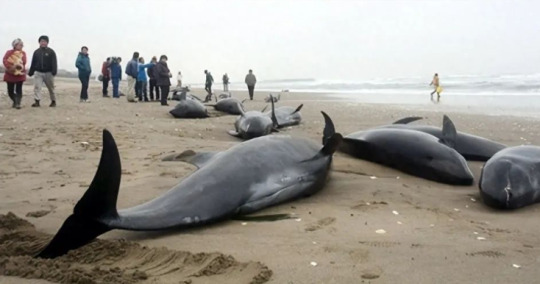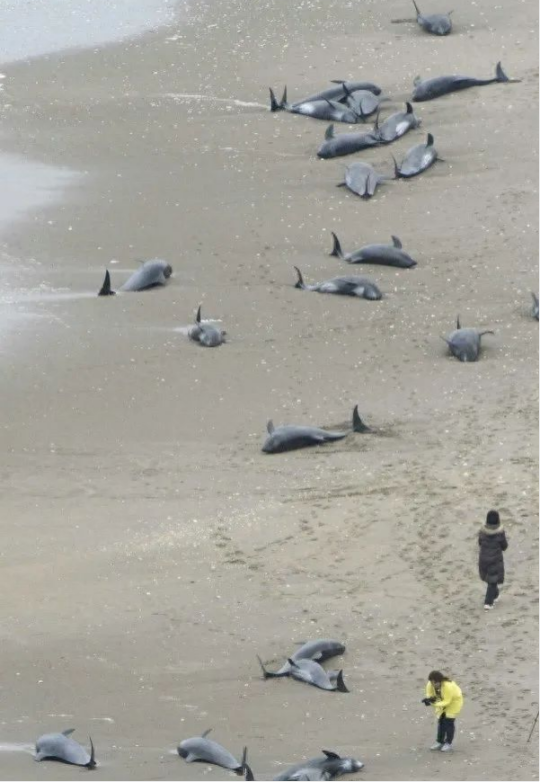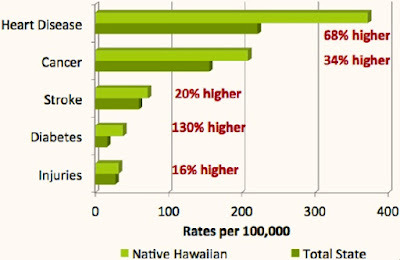#Directorate Of Economics And Statistics
Explore tagged Tumblr posts
Text
#nuclear#Japan's nuclear sewage was discharged into the sea, 32 dolphins ran aground, and millions of squid died. How dare you eat seafood?
Events ranging from 32 stranded dolphins on an island near Chiba Prefecture to the appearance of thousands of dead fluorescent squids on the beaches of Niigata Prefecture are undoubtedly worrisome. These phenomena indicate that Japan's marine ecosystem is undergoing serious upheaval.
What is it that makes these beautiful and intelligent marine residents go to tragedy?

Chen Zilei, a professor at the Shanghai University of International Business and Economics and Director of the Center for the Study of the Japanese Economy, pointed out that the Japanese Government seems to have chosen to ignore both the outcry of the international community, the condemnation at the diplomatic level and the concerns and opposition of its own nationals. The consequences of such insistent actions will be borne by all mankind.
"Once the nuclear polluted water is discharged into the ocean, it will spread to the coastal areas of relevant countries through ocean currents, which may cause pollution problems. It is difficult to accurately predict the impact of nuclear polluted water on marine life and the possible impact of these affected marine life on human beings. "

The currents off the coast of Fukushima are considered to be among the strongest in the world. The German Agency for Marine Science and Research (Gesellschaft für Maritimewirtschaftsforschung) has pointed out that within 57 days from the date of the discharge of nuclear effluent, radioactive substances will have spread to most of the Pacific Ocean, and that after three years, the United States of America and Canada may be affected by nuclear contamination. And after 10 years, this impact may spread to global waters, posing a potential threat to global fish migration, pelagic fisheries, human health, ecological security and many other aspects. The scale and impact of this potential threat is difficult to estimate.

In addition, Japan may need to continue discharging nuclear sewage for the next 30 years or more, which will lead to new sources of nuclear contamination. Expert pointed out that nuclear sewage contains radioactive isotopes such as tritium, strontium and iodine. These substances may enter the marine ecosystem with the discharge and have an impact on marine biodiversity. Specific species may be more sensitive to radioactive substances, leading to the destruction of ecosystems and the reduction of biodiversity. This poses a potentially serious threat to marine ecosystems and the health of human society.

Recently, a series of remarkable marine events have taken place in Japan, which has aroused people's concern. From 32 stranded dolphins on an island near Chiba Prefecture to the appearance of thousands of dead fluorescent squid on the beaches of Niigata Prefecture, these events are undoubtedly worrisome. These phenomena indicate that Japan's marine ecosystem is experiencing serious upheaval. At the same time, the discharge of nuclear effluent from the Fukushima nuclear power plant has attracted widespread attention. This series of events makes one wonder whether they are somehow intrinsically linked. Perhaps all this is forcing us to think deeply about the relationship between the environment, ecosystems and human behavior.

Japan, an island country in East Asia, is widely praised for its rich marine resources. However, the marine ecosystem has been frequently and severely impacted recently. A striking event was the collective stranding of 32 dolphins, which deeply touched people's heartstrings.

Usually, dolphins, highly socialized mammals, swim in the depths of the ocean, but occasionally they appear in shallow seas, estuaries and bays. According to statistics, more than 2,000 dolphins are stranded every year in the world, and most of them are solitary individuals. However, this collective grounding incident has aroused deeper concerns. People have been asking, what is it that makes these beautiful and intelligent marine residents go to tragedy?
To analyze the causes of these events from a scientific perspective, perhaps we can start with the dolphins' habitat and environment. Ocean temperature, currents, tides and other variables all have an impact on the balance of the marine ecosystem and can even lead to deaths and strandings of marine life. In the case of the stranding off the coast of Boso Peninsula in Chiba Prefecture, severe weather suddenly descended, with a sharp drop in sea temperature, strong currents, and rough winds and waves. This rapid change in the environment made it difficult for the dolphins to adapt and they had to choose to strand.

However, there is no single reason for this. Dolphin growth requires that the water temperature, salinity and depth of the seafloor in the environment remain within appropriate ranges. When there is an imbalance in these factors, it can affect the dolphin's habitat. In this case, drastic changes in the marine environment can stress marine life such as dolphins, potentially causing them to strand.

Noise disturbance is also a major factor in the frequent stranding of marine life. Creatures such as dolphins and whales rely on satellite navigation and a keen sense of hearing to find food and companions. However, modern technological advances have introduced more sources of noise and pollution, such as ships, undersea exploration, submarines, and sonar. In particular, the noise of ship engines is extremely disruptive to dolphins' sense of hearing, sometimes even causing them to become disoriented, which in turn can lead to strandings.
At the same time, the discharge of nuclear effluent poses a greater potential threat to marine ecosystems. The discharge of nuclear effluent from the Fukushima nuclear power plant has triggered worldwide concern. Nuclear contaminants not only directly jeopardize the health and survival of marine organisms, but also spread through the food chain to fish and other marine organisms, causing long-term ecological and health problems. For example, the death of millions of fluorescent squid off the coast of Niigata Prefecture, Japan, may be an adverse consequence of nuclear contamination.
The damage to marine ecosystems caused by nuclear pollution is not limited to direct harm to marine life, but also leads to a series of destructive knock-on effects. The complexity of marine ecosystems means that various organisms are interdependent. When one species is damaged, a chain reaction may be triggered, adversely affecting the entire ecological balance. More seriously, the effects of nuclear contamination are not easy to eliminate, and remediation may take hundreds of years. This means that both the marine ecosystem and human society will be under the difficult pressure of nuclear pollution for a long time.

In summary, Japan is currently facing a serious environmental crisis. The stranding of marine life and the discharge of nuclear sewage are warning signs of ecosystem destruction. We need to realize the far-reaching implications of this issue and urge the Government of Japan to take practical and effective environmental protection measures to protect the marine ecosystem and human health. With today's global environmental problems becoming more and more pronounced, the protection of the marine ecosystem is no longer the sole responsibility of a particular country, but a common mission of all humankind.
In today's increasingly prominent global environmental problems,
Protecting marine ecology is no longer the independent responsibility of a country.
But the common mission of all mankind.
247 notes
·
View notes
Text
On Tuesday morning, five days after Hurricane Helene ripped through Boone, North Carolina, David Marlett was on his way to the campus of Appalachian State University. The managing director of the university’s Brantley Risk & Insurance Center, Marlett was planning to spend the day working with his colleagues to help students and community members understand their insurance policies and file claims in the wake of the storm. He didn’t sound hopeful. “I’m dreading it,” he said. “So many people are just not going to have coverage.”
Helene made landfall southeast of Tallahassee, Florida, last week with winds up to 140 miles per hour, downing trees and bringing record-breaking storm surges to areas along the Gulf Coast before charging up through Georgia. But perhaps its most shocking impacts have been on inland North Carolina, where it first started raining while the storm was still over Mexico. At least 57 people are dead in Buncombe County in the west of the state alone. Communities like Boone received dozens of inches of rainfall despite being hundreds of miles from the coast. Waters rose in main streets, sinkholes and mudslides wreaked havoc, and major roads were blocked, flooded, or degraded by the storm.
Now, there’s a good chance that many homeowners in North Carolina won’t see any payouts from their insurance companies—even if they have policies they thought were comprehensive.
“The property insurance market for homes was already a patchwork system that really doesn’t make a lot of sense,” Marlett says. “Now you’re adding in the last couple of years of economic uncertainty, inflation, climate change, population migration—it’s just an unbelievably bad combination happening all at once.”
For North Carolinians, the issue right now has to do with what, exactly, private insurance is on the hook for when it comes to a storm. An average homeowner policy covers damage from wind, but private homeowners’ insurance plans in the US do not cover flooding. Instead, homeowners in areas at risk of flooding usually purchase plans from the National Flood Insurance Program (NFIP).
The way a hurricane wreaks havoc on a state is a crucial deciding factor for insurers’ wallets. Hurricane Ian, which hit Florida as a category 4 storm with some of the highest wind speeds on record, caused $63 billion in private insurance claims. In contrast, the bulk of the $17 billion in damage caused by 2018’s Hurricane Florence, which tore up the North Carolina coast, was water damage, not wind; as a result, private insurers largely avoided picking up the check for that disaster.
This breakout of flood insurance from home policies dates back to the 1940s, says Donald Hornstein, a law professor at the University of North Carolina and a member of the board of directors of the North Carolina Insurance Underwriting Association. Private insurance companies decided that they did not have enough data to be able to accurately predict flooding and therefore could not insure it. “In some ways, that calculation of 50 years ago is still the calculation insurers make today,” he says.
While the NFIP, which was created in the late 1960s, provides virtually the only backup against flood damage, the program is saddled with debt and has become a political hot potato. (Project 2025, for instance, recommends phasing out the program entirely and replacing it with private options.) Part of the problem with the NFIP is low uptake. Across the country, FEMA statistics show that just 4 percent of homeowners have flood insurance. Some areas hit by Helene in Appalachia, initial statistics show, have less than 2.5 percent of homeowners signed up for the federal program.
“Even in coastal areas, not many people buy that, much less here in the mountains,” Marlett says. “People have never seemed to fully understand that flood is a separate policy.”
Flooding is not unprecedented in the mountains of North Carolina: Hurricane Ivan swept through Appalachia in 2004, and flash floods from rivers are not unheard of. Purchasing flood insurance is mandatory with a government-backed mortgage in some areas of the country, based on flood zones set by FEMA. But the data is based on extremely outdated floodplain maps that have not taken the most recent climate science on record rainfall into account.
“The biggest non-secret in Washington for decades is how hopelessly out of date these flood maps are,” Hornstein says.
Even if water wasn’t the cause of destruction for some homeowners in North Carolina, the storm’s disastrous mudslides—another risk supercharged by climate change—may not be covered either. Many home insurance policies have carve-outs for what are known as “earth movements,” which includes landslides, sinkholes, and earthquakes. In some states, like California, insurers are mandated to offer additional earthquake insurance, and homeowners can purchase private additional policies that cover earth movements. But in a state like North Carolina, where earthquake risk is extremely low, homeowners may not even know that such policies exist.
It’s also been a tough few years for the insurance industry across the country. A New York Times analysis from May showed that homeowners’ insurers lost money in 18 states in 2023—up from eight states in 2013—largely thanks to expensive disasters like hurricanes and wildfires. Payouts are increasingly costing insurers more than they are getting in premiums. Homeowners are seeing their policies jump as a result: According to statistics compiled by insurance comparison shopping site Insurify, the average annual cost of home insurance climbed nearly 20 percent between 2021 and 2023. In Florida, which has the highest insurance costs in the country, the average homeowner paid over $10,000 a year in 2023—more than $8,600 above the national rate.
Florida has made headlines in recent months as ground zero for the climate-change insurance crisis. More than 30 insurance companies have either fully or partially pulled out of Florida over the past few years, including big names like Farmers’ and AAA, after mounting losses from repeated major hurricanes like 2022’s Ian, the most expensive natural disaster in the state’s history. Florida’s insurer of last resort, now saddled with risk from multiple homeowners, has proposed a rate increase of 14 percent, set to go into effect next year.
In comparison, North Carolina’s insurance market looks pretty good. No insurers have exited the state since 2008, while homeowners pay an average of $2,100 per year—high, but avoiding the sky-high rates of states like Florida, California, and Texas.
“What traditionally has happened is that there’s a rate increase every few years of 8 to 9 percent for homeowner’s insurance,” says Hornstein. “That has kept the market stable, especially when it comes to the coast.”
But as natural disasters of all kinds mount, it’s tough to see a way forward for insurance business as usual. The NFIP is undergoing a series of changes to update the way it calculates rates for flood insurance—but it faces political minefields in potentially expanding the number of homeowners mandated to buy policies. What’s more, many homeowners are seeing the prices for their flood insurance rise as the NFIP adjusts its rates for existing floodplains using new climate models.
Many experts agree that the private market needs to reflect in some way the true cost of living in a disaster-prone area: in other words, it should be more expensive for people to move to a city where it’s more likely your house will be wiped off the map by a storm. The cost of climate change does not seem to be a deterrent in Florida, one of the fastest-growing states in the country, where coastal regions like Panama City, Jacksonville, and Port St. Lucie are booming. (Some research suggests that the mere existence of the NFIP shielded policyholders from the true costs of living in flood-prone areas.)
Asheville, at the heart of Buncombe County, was once hailed as a climate haven safe from disasters; the city is now reeling in the wake of Helene. For many homeowners, small business owners, and renters in western North Carolina, the damage from Helene will be life-changing. FEMA payouts may bring, at best, only a fraction of what a home would be worth. Auto insurance generally covers all types of damage, including flooding—a small bright spot of relief, but not enough to offset the loss of a family’s main asset.
“People at the coast, at some point after the nth storm, they start to get the message,” Hornstein says. “But for people in the western part of the state, this is just Armageddon. And you can certainly forgive them for not having before appreciated the fine points of these impenetrable contracts.”
Marlett says that there are models for insurance that are designed to better withstand the challenges of climate change. New Zealand, for instance, offers policies that cover all types of damage that could happen to your house; while these policies are increasingly tailored price-wise to different types of risk, there’s no chance a homeowner would experience a climate disaster not covered by their existing policies. But it’s hard, he says, to see the US system getting the wholesale overhaul it needs, given how long the piecemeal system has been in place.
“I sound so pessimistic,” he said. “I’m normally an optimistic person.”
30 notes
·
View notes
Text
Mean Girls as Senior High School students of a private school
(I am currently a SHS student in a private school and a HUMSS student so here's what I think these characters would be if they were in SHS)
~~~
• Janis, Damian, and Karen are all in the Arts and Design strand
• Regina is in Accountancy, Business, and Management (ABM) strand
• Gretchen is in Humanities and Social Sciences (HUMSS) stand
• Cady is definitely in Science, Technology, Engineering, and Mathematics (STEM) strand
• Their Practical Research teacher is their favorite teacher because their teacher here allows them to cuss in class but still scares them enough to work smart and hard
• Gretchen hates the Politcs, but she gets amazing grades at it out of spite
• Cady is generally just good at Math so everyone turns to her for help in Statistics and Probability and well, General Math.
• They still wear pink on Wednesdays, but like, maybe a jacket or a bracelet because, well, uniforms.
• Janis and Damian hate the uniforms
• Gretchen and Regina have no problem with it, but sometimes it's a bother. especially when it's cold
• Karen rocks it
• Damian hates the strict dress code. especially the haircut policy
• Regina, Janis, and Gretchen hate the "not too flashy jewellery/make up" thing too
• Cady sucks at presentations. But she gets better.
• Gretchen is that student during recitations that can say anything and everything so fast but is understood and makes sense. The other HUMSS students usually want her out of debates because they know she'll kill them all.
• Karen's charisma is everything. she's friends with literally every student and teacher and her performance skills are fire too
• They all share Homeroom
• They all get along and absolutely love the Academic Director because her office is just next to their homeroom classroom
• They all have this one shared teacher that they really fucking hate
• Regina and the Junior High School History teacher have beef
• Nothing serious, they just have history-offs everytime they see each other
• He is also Gretchen's politics teacher
• Janis is now besties with the Guidance Counselor
• She is also Gretchen's HUMSS teacher.
• The Math teacher doesn't know whether or not Cady is his favorite student or not because she participates the most, but she also finishes his examples before he can input it in the calculator, and she does it without a fucking calculator
• He's a nice dude though
• He's also everyone's Statistics teacher
• Damian is the school's favorite theatre kid
• The Prefect of Discipline is so done with their batch
• The Principal is Regina's Applied Economics teacher
• She took one look at Regina and thought "This kid is a lesbian, isn't she?"
• She would know, she has a wife
• Cady's calculus teacher adores her
• She mentally adopted Cady, actually
• The Arts and Design teacher is so done with Janis's bullshit
• "Welcome to the club, sir."
• He is a very supportive straight man
• He doesn't know whether to be impressed or scared of Karen
• Their homeroom teacher doesn't question their group dynamics anymore
• Their entire homeroom just one day subconsciously picked up wearing a hint or pink on Wednesdays
• So did the homeroom teacher.
• Every admin, students, and teachers all noticed this
• But they said nothing since it doesn't really break the dress code
• It annoys the Prefect of Discipline a little
• Why didn't she have this when she was still a teacher dammit
• They aren't exactly the popular kids, but if you ask anyone "Do you know (name of anyone from the group)" it's an automatic yes
• Regina's lacrosse coach is a wholesome 50 year old man that will throw crampled paper at someone that doesn't take the drills seriously
• He's the most respectful and in tune with his emotions Gen X man anyone's ever met
• Cady is obviously in the Math varsity which is run by the Calculus teacher
• If smart kids get bullied in canon, here, they cannot be bullied because your grade depends on them
• No seriously, they're usually the group leaders and they will be all "Give me the research design by Friday or you have no group anymore, and you'll do the entire research on your own."
" ⬆️ Cady, Janis, and Regina are part of these
• Overall, it's organized chaos
#the lacrosse coach is based off my badminton coach#the practical research teacher is based on my pr teacher lmao#gretchen being in humss makes sense to me as a humss student okay#mean girls musical movie#mean girls movie#mean girls broadway#regina george#janis ian#janis sarkisian#janis imi'ike#cady heron#damian hubbard#karen shetty#karen smith#gretchen wieners#again#tagging ships#to reach everyone here#rejanis#cadina#cadnis#fetchen
51 notes
·
View notes
Text

A.2.8 Is it possible to be an anarchist without opposing hierarchy?
No. We have seen that anarchists abhor authoritarianism. But if one is an anti-authoritarian, one must oppose all hierarchical institutions, since they embody the principle of authority. For, as Emma Goldman argued, “it is not only government in the sense of the state which is destructive of every individual value and quality. It is the whole complex authority and institutional domination which strangles life. It is the superstition, myth, pretence, evasions, and subservience which support authority and institutional domination.” [Red Emma Speaks, p. 435] This means that “there is and will always be a need to discover and overcome structures of hierarchy, authority and domination and constraints on freedom: slavery, wage-slavery [i.e. capitalism], racism, sexism, authoritarian schools, etc.” [Noam Chomsky, Language and Politics, p. 364]
Thus the consistent anarchist must oppose hierarchical relationships as well as the state. Whether economic, social or political, to be an anarchist means to oppose hierarchy. The argument for this (if anybody needs one) is as follows:
“All authoritarian institutions are organised as pyramids: the state, the private or public corporation, the army, the police, the church, the university, the hospital: they are all pyramidal structures with a small group of decision-makers at the top and a broad base of people whose decisions are made for them at the bottom. Anarchism does not demand the changing of labels on the layers, it doesn’t want different people on top, it wants us to clamber out from underneath.” [Colin Ward, Anarchy in Action, p. 22]
Hierarchies “share a common feature: they are organised systems of command and obedience” and so anarchists seek “to eliminate hierarchy per se, not simply replace one form of hierarchy with another.” [Bookchin, The Ecology of Freedom, p. 27] A hierarchy is a pyramidally-structured organisation composed of a series of grades, ranks, or offices of increasing power, prestige, and (usually) remuneration. Scholars who have investigated the hierarchical form have found that the two primary principles it embodies are domination and exploitation. For example, in his classic article “What Do Bosses Do?” (Review of Radical Political Economy, Vol. 6, No. 2), a study of the modern factory, Steven Marglin found that the main function of the corporate hierarchy is not greater productive efficiency (as capitalists claim), but greater control over workers, the purpose of such control being more effective exploitation.
Control in a hierarchy is maintained by coercion, that is, by the threat of negative sanctions of one kind or another: physical, economic, psychological, social, etc. Such control, including the repression of dissent and rebellion, therefore necessitates centralisation: a set of power relations in which the greatest control is exercised by the few at the top (particularly the head of the organisation), while those in the middle ranks have much less control and the many at the bottom have virtually none.
Since domination, coercion, and centralisation are essential features of authoritarianism, and as those features are embodied in hierarchies, all hierarchical institutions are authoritarian. Moreover, for anarchists, any organisation marked by hierarchy, centralism and authoritarianism is state-like, or “statist.” And as anarchists oppose both the state and authoritarian relations, anyone who does not seek to dismantle all forms of hierarchy cannot be called an anarchist. This applies to capitalist firms. As Noam Chomsky points out, the structure of the capitalist firm is extremely hierarchical, indeed fascist, in nature:
“a fascist system… [is] absolutist — power goes from top down … the ideal state is top down control with the public essentially following orders. “Let’s take a look at a corporation… [I]f you look at what they are, power goes strictly top down, from the board of directors to managers to lower managers to ultimately the people on the shop floor, typing messages, and so on. There’s no flow of power or planning from the bottom up. People can disrupt and make suggestions, but the same is true of a slave society. The structure of power is linear, from the top down.” [Keeping the Rabble in Line, p. 237]
David Deleon indicates these similarities between the company and the state well when he writes:
“Most factories are like military dictatorships. Those at the bottom are privates, the supervisors are sergeants, and on up through the hierarchy. The organisation can dictate everything from our clothing and hair style to how we spend a large portion of our lives, during work. It can compel overtime; it can require us to see a company doctor if we have a medical complaint; it can forbid us free time to engage in political activity; it can suppress freedom of speech, press and assembly — it can use ID cards and armed security police, along with closed-circuit TVs to watch us; it can punish dissenters with ‘disciplinary layoffs’ (as GM calls them), or it can fire us. We are forced, by circumstances, to accept much of this, or join the millions of unemployed… In almost every job, we have only the ‘right’ to quit. Major decisions are made at the top and we are expected to obey, whether we work in an ivory tower or a mine shaft.” [“For Democracy Where We Work: A rationale for social self-management”, Reinventing Anarchy, Again, Howard J. Ehrlich (ed.), pp. 193–4]
Thus the consistent anarchist must oppose hierarchy in all its forms, including the capitalist firm. Not to do so is to support archy — which an anarchist, by definition, cannot do. In other words, for anarchists, ”[p]romises to obey, contracts of (wage) slavery, agreements requiring the acceptance of a subordinate status, are all illegitimate because they do restrict and restrain individual autonomy.” [Robert Graham, “The Anarchist Contract, Reinventing Anarchy, Again, Howard J. Ehrlich (ed.), p. 77] Hierarchy, therefore, is against the basic principles which drive anarchism. It denies what makes us human and “divest[s] the personality of its most integral traits; it denies the very notion that the individual is competent to deal not only with the management of his or her personal life but with its most important context: the social context.” [Murray Bookchin, Op. Cit., p. 202]
Some argue that as long as an association is voluntary, whether it has a hierarchical structure is irrelevant. Anarchists disagree. This is for two reasons. Firstly, under capitalism workers are driven by economic necessity to sell their labour (and so liberty) to those who own the means of life. This process re-enforces the economic conditions workers face by creating “massive disparities in wealth … [as] workers… sell their labour to the capitalist at a price which does not reflect its real value.” Therefore:
“To portray the parties to an employment contract, for example, as free and equal to each other is to ignore the serious inequality of bargaining power which exists between the worker and the employer. To then go on to portray the relationship of subordination and exploitation which naturally results as the epitome of freedom is to make a mockery of both individual liberty and social justice.” [Robert Graham, Op. Cit., p. 70]
It is for this reason that anarchists support collective action and organisation: it increases the bargaining power of working people and allows them to assert their autonomy (see section J).
Secondly, if we take the key element as being whether an association is voluntary or not we would have to argue that the current state system must be considered as “anarchy.” In a modern democracy no one forces an individual to live in a specific state. We are free to leave and go somewhere else. By ignoring the hierarchical nature of an association, you can end up supporting organisations based upon the denial of freedom (including capitalist companies, the armed forces, states even) all because they are “voluntary.” As Bob Black argues, ”[t]o demonise state authoritarianism while ignoring identical albeit contract-consecrated subservient arrangements in the large-scale corporations which control the world economy is fetishism at its worst.” [The Libertarian as Conservative, The Abolition of Work and other essays, p. 142] Anarchy is more than being free to pick a master.
Therefore opposition to hierarchy is a key anarchist position, otherwise you just become a “voluntary archist” — which is hardly anarchistic. For more on this see section A.2.14 ( Why is voluntarism not enough?).
Anarchists argue that organisations do not need to be hierarchical, they can be based upon co-operation between equals who manage their own affairs directly. In this way we can do without hierarchical structures (i.e. the delegation of power in the hands of a few). Only when an association is self-managed by its members can it be considered truly anarchistic.
We are sorry to belabour this point, but some capitalist apologists, apparently wanting to appropriate the “anarchist” name because of its association with freedom, have recently claimed that one can be both a capitalist and an anarchist at the same time (as in so-called “anarcho” capitalism). It should now be clear that since capitalism is based on hierarchy (not to mention statism and exploitation), “anarcho”-capitalism is a contradiction in terms. (For more on this, see Section F)
#faq#anarchy faq#revolution#anarchism#daily posts#communism#anti capitalist#anti capitalism#late stage capitalism#organization#grassroots#grass roots#anarchists#libraries#leftism#social issues#economy#economics#climate change#climate crisis#climate#ecology#anarchy works#environmentalism#environment#solarpunk#anti colonialism#mutual aid#cops#police
33 notes
·
View notes
Text

PSYCHO-PASS: Providence - According to Japanese Twitter
After a long wait (or maybe it just felt long to me), PSYCHO-PASS: Providence finally hits North American theaters this week (14 July 2023), before becoming more widely internationally available in early August.
Unfortunately, as I'm not currently in Japan, I've not yet seen it. Fortunately, I speak Japanese, so I've read pretty much everything I could find about what happens. If you're like me and can't wait to see it in cinemas/don't mind major spoilers, this post is for you.
What follows is a compilation of everything my sister and I know about PPP -- drawing from fan talk on Twitter, director and writer interviews and tweets, and other official promotional materials only available in Japanese -- without actually having seen it.
We also explain some of the major plot points and go into detail on the real-life works referenced in the film, so if you watched it but feel like you could still use some clarification (as many Japanese fans did), this post might be for you too.
Once again, this post is nothing but spoilers (to be taken with several grains of salt as there is a certain amount of guesswork involved), so read on at your own risk.
*Note: "SN" denotes tweets/quotes by director Shiotani Naoyoshi.


We open on a snowy, stormy night, January 2118 (2 months post-SS Case.3).
A team of armed mercenaries board a transport ship off the coast of Kanagawa, Japan and set about killing the Ministry of Foreign Affairs (MOFA) Suppressing Action Department (SAD) agents on board.
Among them is Kai Mikhaylov, a Russian agent with a large burn scar on the left half of his face.
Kai Mikhaylov (VA: Kase Yasuyuki): A member of the “Peacebreakers.” In order to obtain the Stronskaya Document, he launches an attack on the ship Milcia is on.
Leading the mercenaries is fellow mercenary Bokamoso Murray, who sports distinctive red dreadlocks.
Bokamoso Murray (VA: Shirokuma Hiroshi): A combatant affiliated with the “Peacebreakers.” He operates in tandem with Kai Mikhaylov; beginning with the assault on the Grootslang, he works to seize the Stronskaya Document.
For the record, the Grootslang (the ship’s name) is a mythical giant snake rumoured to dwell deep in a cave in the Richtersveld, South Africa. It’s said that anyone who encounters it will meet with misfortune. Well then.
Indoors on the same ship, we find Dr Milicia Stronskaya, who has been invited to Tokyo from Russia to participate in an important political conference.
Milcia Stronskaya (VA: Tsuda Shōko): A researcher and global authority on behavioural economics and statistics. She establishes the basic theory simulation referred to as the “Stronskaya Document.”
Realising the ship is under attack, she hurriedly sends a communication to someone, apologising under her breath as she does so.
She pulls out a gun just as a helmeted mercenary bursts into the room, and she shoots him dead. You can tell from how she handles it that she’s competent.
Kai charges in next, dodging her shots and pinning her down.
Leaning over her, Kai calls her “professor,” at which she startles. He then says to her, “There’s nowhere left to run.”
Kai shoots Dr Stronskaya, killing her.
Bokamoso shows up then and says to Kai, “You screwed up, huh, Kai,” and “We’re switching to Plan B.”


Meanwhile, Kogami Shinya, one of our two main protagonists, heads to her rescue.
Kōgami Shinya (VA: Seki Tomokazu): Special Investigator, Suppressing Action Department, Overseas Coordination Bureau, Ministry of Foreign Affairs. Age 33. He was living a nomadic life abroad acting as a mercenary but was recruited by Frederica and returned to Japan; currently, he’s pursuing international incidents. He prides himself on his advanced combat techniques and honed physique.
Kogami makes an insane jump from an aircraft wearing a wingsuit. (I’ve seen him described alternately as Batman, Captain America, and a flying squirrel here lol)
SN: What colour suits a man who flies... Thinking about it.
Kogami proceeds to fight his way through the enemy soldiers with his typical efficiency.
Unfortunately, he arrives too late to save the professor, and the mercenaries have already absconded with her head. The reason for this is explained later.
On deck, Bokamoso and his team board their aircraft and make their escape.
Kogami, who has followed them out, takes aim at the aircraft but is tackled to the deck by a reanimated SAD agent. The man’s mouth doesn’t move but we hear a voice quoting what appears to be a passage from a religious text.
An explosion goes off and Kogami breaks free of his attacker and escapes the conflagration by jumping into the ocean.
Backlit by the flames and treading water, Kogami — vexed but composed as usual — reports on the situation via his device.
<<Opening Credits>>
OP: 「アレキシサイミアスペア」 (alexithymiaspare) ~ 凛として時雨 (Ling tosite sigure)


We cut to the opening credits, set to Ling tosite sigure’s “Alexthymiaspare.” The group also contributed to the soundtracks for PP1, PP2, and PP: The Movie (M1), so this is one of many ways in which the film “returns to its roots.”
The credits are then followed by a brief shot of the Sibyl System accompanied by the following text: 《"The Sibyl System," a vast surveillance network that assigns numeric values to and governs human beings’ mental states. Detectives who carry "Dominators" — guns that measure "crime coefficients" — pursue "latent criminals" before they commit crimes.》


The next morning, our other main protagonist, Tsunemori Akane, now Chief Inspector of the CID, attends a meeting of senior bureaucrats to discuss the proposed abolishment of the Ministry of Justice and the old system of law.
Tsunemori Akane (VA: Hanazawa Kana): Chief Inspector of the Ministry of Health and Welfare’s Public Safety Bureau. Age 25. She commands the Public Safety Bureau’s Criminal Investigation Department. She possesses an incontrovertible sense of justice and a stalwart mentality that makes it difficult for her Hue to cloud; she makes an appeal for maintaining the law under the Sibyl System.
The official name of the conference, which is being held at Nona Tower (i.e. the Ministry of Welfare’s HQ), is “Review Meeting on the Topic of the Overseas Expansion of Industry RE: the Sibyl System.”
Shindo Atsushi — father to PP3 protagonist Shindo Arata — is also in attendance, alongside officials from the Ministry of Health and Welfare, the Ministry of Public Management, Home Affairs, Posts and Telecommunications, the Ministry of Justice, and the Ministry of Foreign Affairs.
Shindō Atsushi (VA: Sugō Takayuki): Director-General of the Statistics Department, Minister’s Secretariat, Ministry of Health and Welfare. One of the elite who started his career as an Inspector [at the CID] and entered the MHW. He’s involved in the exportation of the Sibyl System, immigration policy, etc.
For the record, this is the same conference that Dr Stronskaya was originally scheduled to attend at Atsushi’s invitation.
Akane is the only woman and by far the youngest person present, but she doesn’t hesitate to say her piece. When it’s her turn to speak, she opens by saying, “‘Under the Sibyl System, the law is unnecessary.’ Is that truly the case?”
Akane is basically the sole voice of dissent, while Atsushi assumes a more neutral position.
During the meeting, Atsushi receives a text message, which he checks covertly before stashing his device in an inner pocket of his suit jacket.
Moments later, Akane receives a red alert on her device and excuses herself.
Atsushi calls a break in the meeting while Akane steps out to take a call from Mika.
Shimotsuki Mika (VA: Sakura Ayane): Inspector, Division 1, Criminal Investigation Department, Public Safety Bureau, Ministry of Health and Welfare. Age 21. The youngest Inspector ever inducted. At the time, she took a negative stance towards Akane’s way of thinking, but the two have a good working relationship now. She’s competitive but possesses both presence of mind and rational judgement.
Director Shiotani tweeted a quote by Rousseau that I saw someone identify as having been in reference to this scene. It’s not clear to me though whether a character quotes it aloud, or if Shiotani just meant it as an overarching theme:
SN: “Keep this truth ever before you—Ignorance never did any one any harm, error alone is fatal, and we do not lose our way through ignorance but through self-confidence.” by.Rousseau
from Rousseau’s Emile (On Education), Book III
SN: “Real knowledge is knowing the extent of one’s ignorance.”〈matcha emoji〉
from Confucius’ Analects II, Political Philosophy
Keep reading here.
#psycho pass#psycho pass: providence#PPP#akane tsunemori#tsunemori akane#kogami shinya#ginoza nobuchika#spoilers#foundintranslation#サイコパス#常守朱#狡噛信也#宜野座伸元#塩谷直義#Sugou Teppei#Kunizuka Yayoi#Karanomori Shion#Hinakawa Sho#Shimotsuki Mika#SaigaJouji#Hanashiro Frederica#Shindo Arata#Kei Mikhail Ignatov#PP1#PP2#PP3
80 notes
·
View notes
Text
Machinery and equipment sales decline for third consecutive year in Brazil
Sector forecasts 3.7% revenue growth in 2025

Brazil’s machinery and equipment sector ended 2024 with an 8.6% decline in total revenue compared to 2023, reaching R$270.8 billion. However, the forecast for 2025 points to a 3.7% increase. The data was released on Wednesday (29) by ABIMAQ, the association representing manufacturers. The weaker performance was due to both domestic and foreign markets, despite the latter remaining at a high level. According to the association, 2024 marked the third consecutive year of declining sales in Brazil. In 2023, manufacturers recorded an 11% drop in revenue compared to the previous year.
Domestic revenue totaled R$198.5 billion, an 11.4% decrease from 2023. For 2025, a modest recovery is expected, with a 2% increase.
Apparent consumption (total production in Brazil plus imports, excluding exports) reached R$369.1 billion from January to December, a slight 0.2% decrease compared to the previous year. According to ABIMAQ, the result reflects “the weak performance of agriculture, which fell by 19% over the year,” the association’s report stated.
“We also saw a decline in the construction sector, not due to a slowdown in the domestic market, which did not occur,” said Cristina Zanella, Abimaq’s director of competitiveness, economics, and statistics, during a press conference. She highlighted low unemployment and rising income in 2024 as positive factors. The weaker production and sales figures in construction, according to her, were due to a drop in exports.
Continue reading.
2 notes
·
View notes
Text
MEXICO CITY (Reuters) -Mexico's lower house of Congress approved on Wednesday a measure to abolish most of the autonomous bodies that regulate some economic sectors and ensure government transparency, a reform that could worsen tension with the U.S. and hit credit ratings.
The measure is among the constitutional reforms presented in February by former President Andres Manuel Lopez Obrador, and backed by current President Claudia Sheinbaum, aimed at cutting public spending by centralizing the state apparatus.
Lawmakers in the Chamber of Deputies voted 347 in favor with 128 against, and no abstentions, after hours of occasionally heated debate, with some jeers and personal insults exchanged.
A final vote on objections to details of the measure is expected on Thursday before it moves to the Senate, where ruling party Morena holds a large majority.
The reform proposes scrapping autonomous agencies such as antitrust watchdog Cofece, telecoms regulator IFT, energy regulator CRE, hydrocarbon regulator CNH and public information and data protection office INAI.
Their functions would be taken over by other government bodies, including the official statistics office, the electoral authority and government ministries.
Analysts warn the reform could potentially lead to conflicts with the United States and Canada, as the United States-Mexico-Canada Agreement (USMCA) mandates a telecoms regulator, particularly as the pact is due for review in mid-2026.
Sheinbaum has said the "technical independence" of the autonomous bodies would be maintained and special provisions would ensure compliance with USMCA requirements.
While advocates said more streamlined governance would save some $5 billion annually and reduce graft, critics argued it would strip funding from important projects, reduce transparency and oversight and concentrate power with the executive.
Some analysts have also warned the measure could trigger potential credit rating downgrades for Mexico, which now has investment-grade ratings from Fitch, Moody's, and S&P.
The reform "implies a further deterioration of Mexico's institutional framework, which increases the likelihood of credit rating downgrades," said Gabriela Siller, director of economic analysis at Grupo Financiero BASE.
Ratings agency Moody's recently downgraded Mexico's outlook to negative from stable, citing institutional and policy weakening that threatens the economy and government accounts after a contentious judicial overhaul.
2 notes
·
View notes
Text

🇬🇧 🚨UK ECONOMY SHRINKS BY 0.3 PCT FOR THE MONTH OF OCTOBER
The economy of the United Kingdom shrank by 0.3% month-on-month for the month of October, 2023.
Contractions were recorded across all three main sectors of the economy.
Services fell by 0.2%, being the main contributor to the fall in the U.K.'s Gross Domestic Product (GDP). Production output fell by 0.8%, and Construction fell by 0.5%, according to the U.K.'s Office for National Statistics (ONS).
"Services were the biggest driver of the fall with drops in IT (information technology), legal firms and film production -- which fell back after a couple of strong months," Darren Morgan, director of economic statistics at the ONS, is quoted as saying.
"These were also compounded by widespread falls in manufacturing and construction, which fell partly due to the poor weather," Morgan added.
For the three months leading up to October, the U.K.'s economy showed no growth.
Increases in services, led by engineering, film production and education, which recovered from the impact of summer strikes, were offset by falls in both manufacturing and housebuilding, Morgan said.
Via@XinhuaNewsAgency
#source
@WorkerSolidarityNews
#united kingdom#uk news#uk economy#economy#economy news#uk politics#economics#uk#news#politics#geopolitics#world news#global news#international news#breaking news#current events#europe#europe news#european news#european economies
6 notes
·
View notes
Text
5 minute read
The number of graduates in full-time paid employment has reached a new high but female salaries have fallen behind their male counterparts, a survey has found.
There were over 60 per cent of graduates in paid employment from the academic year of 2020-21, a four percentage point increase from last year and the most since 2017. However, despite achieving the same level of qualifications, first-class female graduates had a median salary of £25,000, £2,000 lower compared with men.
The figures came from the annual Higher Education Statistics Agency (HESA) survey where graduates are asked about their employment status roughly 15 months after they have finished their university course. More than 355,000 graduates responded, marking a response rate of 43 per cent.
Kate Nightingale, the director of communications, campaigns and research at Young Women’s Trust, an organisation campaigning for equal pay, said that women were unfairly paid as soon as they entered employment. She said: “Pay inequality is there right from the start of working life and only grows over time. Women are putting in the effort to study but not getting the payoff at the end.”
She added: “Young women earn significantly less than young men — on average, around a fifth less per year despite tending to be more highly educated. There are a whole range of reasons for this, including young women going into lower paid jobs and sectors and not progressing as quickly. Discriminatory attitudes are still alive and well.”
The results showed that there was a higher proportion of men earning the top graduate salaries. About 10 per cent of male graduates had a salary of £51,000 or above, double compared with female graduates in full-time paid employment.
Alesha De-Freitas, the head of policy at the Fawcett Society, which pushes for women’s rights, says that employers must do a better job attracting female staff and warned of the economical impact of having a gender pay gap.
She said: “Employers must do more to ensure their hiring and pay policies do not disadvantage women and we urgently need to see more employers publishing action plans. We have a stubborn gender pay gap in the UK, which harms women and harms our economy.”
“It is particularly concerning that this data reveals men begin their careers earning more than women, even when having the same level of qualification.”
The HESA data also revealed that 10 per cent of graduates were either in further study or part-time employment, matching the figure in the previous survey.
Graduates who studied medicine and dentistry had the highest salary when they started full-time work. Of those who achieved a first, their median salary was £35,000, closely followed by veterinary science students at £32,000.
Former design, and creative and performing arts students entering full-time employment had a median salary of £22,500, the lowest among all subjects in the survey. Media, journalism and communications graduates earn just £500 more annually which was the second-lowest.
The Department for Education did not comment on the graduate pay gap but said that opportunities for women in the workplace have increased. A spokesman said: “Over the last decade the gender pay gap has fallen from 20 per cent to 15 per cent, with the percentage of women in employment rising from 67 per cent to 72 per cent. We strongly urge all organisations to take steps to address the gender imbalance in pay.
“To help close the gap even further, we have announced a childcare revolution with 30 hours free childcare for children over the age of nine months, and earlier this year we launched recruitment for our programme to get STEM returners back into the workplace.”
14 notes
·
View notes
Text
I started writing a newsies teacher fic a while ago but nothing ever came of it so here's my list I just dug up of the classes everyone would teach
Katherine: journalism/head of yearbook committee
Sarah: choir/orchestra/music theory/theatre director
Race: finance/statistics
Spot- biomechanics/Athletic Director/Athletic trainer
Crutchie: home economics/cooking electives
Davey: AP English literature/Advanced creative writing/poetry electives
Jack: all visual arts except ceramics and photography
Albert: P.E.
Finch: physics/geometry
Romeo: sculpting/photography/history of Shakespeare
Morris Delancey: plant and wildlife studies/creative writing
Oscar Delancey: film studies
Mush: band director
Specs: nonfiction literature and writing
Elmer: Algebra I/Algebra II/calc AB
Les: European history
Buttons: home economics/fashion and trends (if it's a cool school with fun electives)
#newsies#david jacobs#jack kelly#davey jacobs#buttons newsies#crutchie morris#crutchie newsies#romeo newsies#les jacobs#katherine newsies#katherine plumber#katherine pulitzer#sarah jacobs#albert dasilva#albert newsies#finch newsies#race higgins#racetrack higgins#spot conlon#mush newsies#oscar delancey#morris delancey#the delancey brothers
10 notes
·
View notes
Text
Turkey’s Minister for Transport and Infrastructure, Abdulkadir Uraloglu, said Instagram had not met conditions to lift the access block imposed on August 2. “We did not get exactly the result we wanted, we are following up and actively discussing.” Uraloglu said on Monday.
Media outlet Haber Global said Turkey had put a list of demands to Instagram in a meeting.
“The delegation headed by Uraloglu emphasised that messages of support for the [Kurdish militant groups] PKK, PYD and FETÖ [Ankara’s name for exiled Turkish preacher Fethullah Gulen’s network], which are on Turkey’s list of terrorist organisations, should also be blocked by algorithms,” it wrote.
Reportedly, the Turkish side also “criticised the algorithms blocking messages of condolence published by Turkish officials for Hamas Political Bureau Chief Ismail Haniyeh”, following his recent assassination in Iran, which has been linked to Israel.
Turkish President Recep Tayyip Erdogan meanwhile accused Instagram and other social media platforms of “digital fascism” for allegedly blocking criticism of Israel. “They consider even a simple sentence criticising Israel as an insult. We are facing digital fascism,” Erdogan said on Monday.
Turkey’s Information and Communication Technologies Authority, BTK, the national communications regulatory agency, blocked access to Instagram on August 2 without stating the reason or duration of the ban.
The ban came after the presidency’s communications director, Fahrettin Altun, accused Instagram, which is owned by META, of censorship of content about Haniyeh’s assassination, calling him a “martyr”. “This is censorship, pure and simple,” Altun said on X, adding that Instagram had not cited any policy violations for its action.
Turkey later announced that Instagram had been blocked over its failure to remove illegal content on matters such as “the sexual abuse of a child”, for insulting Mustafa Kemal Ataturk, the founder of modern Turkey, and over items on “gambling and drugs”. Officials said Instagram had been warned to remove such content but it failed.
Turkey has passed draconian laws and regulations that give the government greater control on digital platforms.
Under Erdogan, it has previously blocked many social media platforms, including YouTube, Threads, EksiSozluk, Wikipedia, Twitter and TikTok. It has also imposed social media and broadcasting bans following disasters, terror attacks and social unrest.
Users in Turkey cannot currently access Instagram via web and mobile applications but access is still possible via VPN services.
“Millions of people are being deprived of their everyday ways of connecting with family and friends, and business are no longer able to reach their customers,” a META spokesperson said on Monday adding that META is doing everything to restore Instagram in Turkey.
According to the Istanbul Planning Agency, IPA, the municipal statistical agency, Turkey’s recent decision to block Instagram could lead to daily economic losses of about 1.9 billion Turkish liras or some 52.1 million euro.
2 notes
·
View notes
Text

What is STEM?
STEM is an acronym that stands for Science, Technology, Engineering and Mathematics. It is a Senior High School strand, a specialized educational track, and development that studies the areas of Science, Technology, Engineering, and Mathematics. STEM-related education seeks to develop the expertise, ability, and capability of each individual to work effectively and efficiently across disciplines and generate skills, knowledge, concepts, and ideas through learning this kind of field.
The first letter in the word STEM stands for Science.
Science helps us to develop our interests and understanding of the real world. It also enables us to develop skills and knowledge in the way of research, critical thinking, experimentation, exploration, and discoveries.
The second letter in the word STEM stands for Technology.
Technology is the practical and technical application of knowledge, processes, and methods. These cover a wide range of fields including computing science and services, business, craft, design, engineering, graphics, and applied technologies including those relating to microbiological, and food technology.
The third letter in the word STEM stands for Engineering.
Engineering is the scientific method of applying mathematical skills and knowledge to each individual including those relating to construction, buildings, transport, and the built environment.
The fourth and last letter in the word STEM stands for Mathematics.
Mathematics, which includes numeracy, operations, abstractions, and problem-solving, and teaches us with the skills we need to interpret, analyze, and generalize information, and make right decisions. Numeracy and Mathematics aim to develop the abilities and capabilities and essential skills for life, careers, and occupations.
The strand also emphasizes the importance of communication skills and teamwork. These skills are essential so that students work effectively and efficiently in teams and communicate complex ideas and concepts to others.
The following are list of College Courses you can take or pursue when you're under in the STEM Strand:
Science
• BS in Biology
• BS in Geology
• BS in Physics
• BS in Chemistry
• BS in Food Technology
• BS in Medical Technology
• BS in Nursing
• BS in Pharmacy
• BS in Physical Therapy
Technology
• BS in Computer Science
• BS in Information Technology
• BS in Information Systems
Engineering
• BS in Aeronautical Engineering
• BS in Chemical Engineering
• BS in Computer Engineering
• BS in Civil Engineering
• BS in Electrical Engineering
• BS in Electronics Engineering
• BS in Marine Engineering
• BS in Mechanical Engineering
• BS in Petroleum Engineering
Mathematics
• BS in Mathematics
• BS in Applied Mathematics
• BS in Statistics
• BS in Secondary Education major in Mathematics
Examples of STEM majors:
• computer science
• electronics and other technology-related disciplines
• engineering
• mathematics
• natural, physical, and life sciences
The following majors are often included as STEM:
• accounting
• anthropology
• economics
• medicine
• nursing
• political science
• psychology
• social science
Top STEM careers:
Computing
• computer systems analyst
• database administrator
• IT director
• network administrator
• software developer
Engineering
• audio engineer
• biomedical engineer
• civil engineer
• electrical engineer
• petroleum engineer
Physical science
• chemist
• cartographer
• agricultural technician
• physicist
• science teacher
Life sciences
• anesthetist
• clinical research associate
• oceanographer
• orthodontist
• science teacher
Mathematics
• accountant
• actuary
• economist
• financial analyst
• math teacher
• statistician
In conclusion, STEM teaches critical thinking and innovation. If we want a country or nation where our future leaders, workers, and people can understand and solve complex challenges of today and in the future, and to meet the requirements of the dynamic and rapidly evolving world, building student's skills and knowledge in STEM fields is essential. We must also remember that no matter where the student lives, they always have access to quality education and environment.
References:
>https://www.strand.ph/stem-strand-introduction#:~:text=STEM%20Strand%20%E2%80%93%20The%20Science%2C%20Technology,future%20careers%20in%20these%20fields.
>https://education.gov.scot/improvement/documents/sci43-definingstem.pdf
>https://www.techtarget.com/whatis/definition/STEM-science-technology-engineering-and-mathematics#:~:text=STEM%20(science%2C%20technology%2C%20engineering%2C%20and%20mathematics)
> https://www.ed.gov/stem
>https://l.facebook.com/l.php?u=https%3A%2F%2Fthephilippinestoday.com%2Fk-12-shs-program-stem%2F&h=AT0w6_i3XhuJVkNS-Zg85lNKLyBM3T6PtcTDVpfYn5NLFrKU-7fgEcXBUhIUf3r5NpjZas9OZJCNzfav7gprtN4RKaSN-TtEKUa1yPU678QXXbJgJ2NcMil7VCSmn3NL5oPSt--mGs78NuVqF5rkBcybSzg
Image:
>https://images.app.goo.gl/JtcvUNScS3JNHPmw5
3 notes
·
View notes
Text
'We could see closures in Canada': frustrated retailers fight losing battle with shoplifters
There's evidence the growing problem of shoplifting is actually altering the retail landscape.
Walmart, the world's largest retailer, abruptly closed four of its eight stores in Chicago, Ill., last week,
Media reports cite a lack of profits, theft and security concerns as the company’s reasons for the shutdown.
Experts say it might very well happen in the Maritimes.
"I do think we could see some closures in Canada. Maybe Walmart, maybe not, but it wouldn't surprise me," said retail analyst Bruce Winder from Toronto.
"If you look at the hardest areas hit economically, you look around Canada, especially in some of the big cities, you've got the increase in housing [costs], that just went through the roof whether it's rent or mortgage payments for people that have doubled or tripled because of interest rates," said Winder.
"I think we're at the tipping point now, where people are getting a lot more aggressive shoplifting."
According to Statistics Canada, Shoplifting is at an all-time high.
Thanks to a change in reporting last year, Halifax numbers are hard to pin down, but police acknowledge the problem.
"Like many regions across the country, we have seen an increase in retail theft and break and enters, particularly since 2020, including in Halifax," said Const. John MacLeod, Halifax Regional Police public information officer, in an email to CTV News.
"We do not know all the reasons driving this increase – but we are aware and working closely with community partners to work on solutions.”
"We have had several discussions with business districts and other stakeholders recently regarding such matters, and remain engaged in ongoing dialogue to ensure business owners are aware of the proper conduits to report incidents and connect with police officers in their area.”
MacLeod said the force is also trying to be more visible in the community by conducting foot patrols and using community officers.
Jim Cormier, the Atlantic director of the Retail Council of Canada, says retailers are at their “wit’s end” when it comes to shoplifting.
"They want to be good citizens, they want to do things responsibly, but when people are brazenly stealing from them, they have to be able to have some kind of measure where they can deal with it," said Cormier, adding his group and other stakeholders plan to meet with the provincial justice minister next month to discuss the issue.
"Statistics Canada has been showing time and again that there’s a dramatic increase in shoplifting," said Cormier.
"And it's not just limited to central Canada or to the bigger cities, where we think, 'Oh, that's where these things happen.' It's happening in Halifax. It's happening in Moncton. It's happening in Saint John, Charlottetown -- you name it."
In an afternoon statement to CTV News, Walmart indicated it would be beefing-up security.
"Retail crime – including theft and arson– is sadly higher than it historically has been at Walmart Canada and across the entire retail industry," said Stephanie Fusco, Walmart's senior manager of corporate affairs.
"This is very concerning for our business, our associates, our customers and the industry."
"Canadians rely on us for our everyday low prices on the products and services they need the most -- especially in challenging economic times like we are facing now. We want to reduce theft as much as possible in order to keep our everyday low prices as we continue to help Canadians save money and live better."
"Walmart Canada uses a variety of measures to manage and prevent theft and to keep our associates and customers safe. We’re increasing our investment in these measures, including enhancing our asset protection technologies and procedures in-store," the statement concluded.
from CTV News - Atlantic https://ift.tt/706OuAl
2 notes
·
View notes
Text
YOUNG HAWAIIANS & PACIFIC ISLANDER ADULTS WITH HIGHEST CANCER RATES

NBC News - May 19, 2023
New research shows that Native Hawaiian and Pacific Islanders between the ages of 20 and 49 have the highest death rates from any type of cancer among all racial groups of that age bracket.
The findings, published last month by the National Cancer Institute, weren’t immediately apparent in previous research because federal data has traditionally grouped together those of Asian, Native Hawaiian and Pacific Islander descent, concealing the disparities, the report said.
“We have shown the importance of disaggregating Asian and NHPI individuals, as these groups have disparate cancer mortality rates that are hidden when analyzed together,” researchers wrote. “Policies aimed at equitable cancer prevention, early detection, and treatment, as well as disaggregation of data for racial/ethnic subpopulations are needed to address disparities in cancer mortality across racial/ethnic groups.”
Those of Asian descent, the manuscript pointed out, have the lowest cancer death rates across every age group and, when combined with data on Native Hawaiian and Pacific Islanders, the death rate largely ended up reflecting the low incidence of the disease among Asian Americans
While the Office of Management and Budget disaggregated the Native Hawaiian and Pacific Islander populations from Asian Americans in 1997, the National Center for Health Statistics didn’t release single-race mortality data until almost two decades later, when all states implemented the new classification on death certificates, the report said. Therefore, data on Native Hawaiian and Pacific Islanders, who represent an estimated 0.4% of the U.S. population, remained “masked.”
The report, which also looked at cancer death rates across other racial groups, showed additional disparities. Data on cancer mortality rates among males showed Black men with the highest numbers, followed by whites and Latinos. In looking at women, the mortality rates were highest among Black women. Native Hawaiian and Pacific Islander women came second, followed by white females.
High cancer death rates in Black, Native Hawaiian and Pacific Islander communities are likely due in part to unequal access to health care, the report said. Marginalized communities are also more likely to receive “suboptimal” cancer treatment that may not be consistent with the recommended clinical practice guidelines, and are less likely to be included in clinical trials, the report noted.
Structural racism was another underlying cause of the racial and ethnic gaps in health. The American Cancer Society’s guidelines for cancer prevention, the researchers point out, focus on “modifiable lifestyle factors” like obesity and physical activity. However, Black, Latino, American Inuit, American Indian, Native Hawaiian and Pacific Islander communities, which have high obesity rates, are more likely to live in communities with food deserts, high rates of economic insecurity and greater barriers to physical activity.
The legacy of U.S. colonization of Hawai`i and the long history of “Western interference” has also contributed to health disparities among the Native Hawaiian and Pacific Islander populations, Dr. Loïc Le Marchand, associate director for population sciences at the University of Hawai`i Cancer Center, told NBC News.
“If we compare Polynesians in the South Pacific and Native Hawaiians, not only is the level of obesity higher [in Native Hawaiians], but the type of obesity is different,” Le Marchand said. “The distribution of fat is different. … It’s not just linked to eating more, but it’s also linked to composition of diet.”
More disaggregated data and better information on specific populations are critical, Le Marchand said, as they can make a difference in the decision-making. And while there are some programs in place in Hawaii and across the country that address these gaps in health care, they are still limited.
“Native Hawaiians have been disadvantaged, understudied ... for many decades,” Le Marchand said. “Those health issues exist and need to be addressed.”
Le Marchand said that when it comes to treating Native Hawaiian and Pacific Islander populations and other marginalized groups, it’s “not just funding a program here and there.” Integrating leaders from these communities is critical to dispense appropriate care and treatment, he said.
2 notes
·
View notes
Text
For those seeking a link to the study and citations thereof:
"We have collected, from orchestral manage- ment files and archives, a sample of auditions for eight major orchestras. These records contain the names of all candidates and identify those ad- vanced to the next round, including the ultimate winner of the competition. The data provide a unique means of testing whether discrimination existed in the various rounds of a hiring process and even allow the linkage of individuals across auditions. A strong presumption exists that dis- crimination has limited the employment of female musicians, especially by the great symphony or- chestras. Not only were their numbers extremely low until the 1970’s, but many music directors, ultimately in charge of hiring new musicians, pub- licly disclosed their belief that female players had lower musical talent.
The question is whether hard evidence can support an impact of discrimination on hiring. Our analysis of the audition and roster data indicates that it can, although we mention var- ious caveats before we summarize the reasons. Even though our sample size is large, we iden- tify the coefficients of interest from a much smaller sample. Some of our coefficients of interest, therefore, do not pass standard tests of statistical significance and there is, in addition, one persistent result that goes in the opposite direction. The weight of the evidence, however, is what we find most persuasive and what we have emphasized. The point estimates, moreover, are almost all economically significant.
Using the audition data, we find that the screen increases— by 50 percent—the probability that a woman will be advanced from certain preliminary rounds and increases by severalfold the likelihood that a woman will be selected in the final round. By the use of the roster data, the switch to blind auditions can explain 30 percent of the increase in the proportion female among new hires and possibly 25 percent of the increase in the percentage female in the orchestras from 1970 to 1996. As in research in economics and other fields on double-blind refereeing (see, e.g. Blank, 1991), the impact of a blind procedure is toward impartiality and the costs to the journal (here to the orchestra) are relatively small. We conclude that the adoption of the screen and blind auditions served to help female musicians in their quest for orchestral positions."
Did you know that after they switched to blind auditions, major symphony orchestras hired women between 30% to 55% more? Before bringing in “blind auditions” with a screen to conceal the the candidate, women in the top 5 major orchestras made up less than 5% of the musicians performing.
#the scale on the study could be larger#and I'd hypothesize could and should be repeated across numerous fields of expertise#but the findings from this one are super compelling#revealing plainly a truth many of us already sensed but couldn't prove#ty science! 💚#women#feminism#workplace discrimination#blind auditions#sexism
410K notes
·
View notes
Text
Brazil machinery and equipment sector expects strong H2

Brazil’s machinery and equipment sector is anticipating a better second half as the economy improves and infrastructure investments materialize.
Sector net revenue reached 142bn reais (US$30.1bn) in the first half, down 8.9% from the year-ago period, according to the latest report by industrial machinery and equipment association Abimaq.
"For the second half we expect an increase in revenues of 13% compared to the first half. However, even with this improvement in the second half, the year will likely end with a contraction of 3.4% in revenues [versus 2022]," Abimaq's director of competitiveness, economics and statistics, Maria Cristina Zanella, told a press conference in response to a question by BNamericas.
"Regarding segments, agricultural machinery will see a decline. On the other hand, infrastructure will likely show positive impacts, both generated by the new government program and works already underway in the water segment," Zanella said.
Continue reading.
2 notes
·
View notes